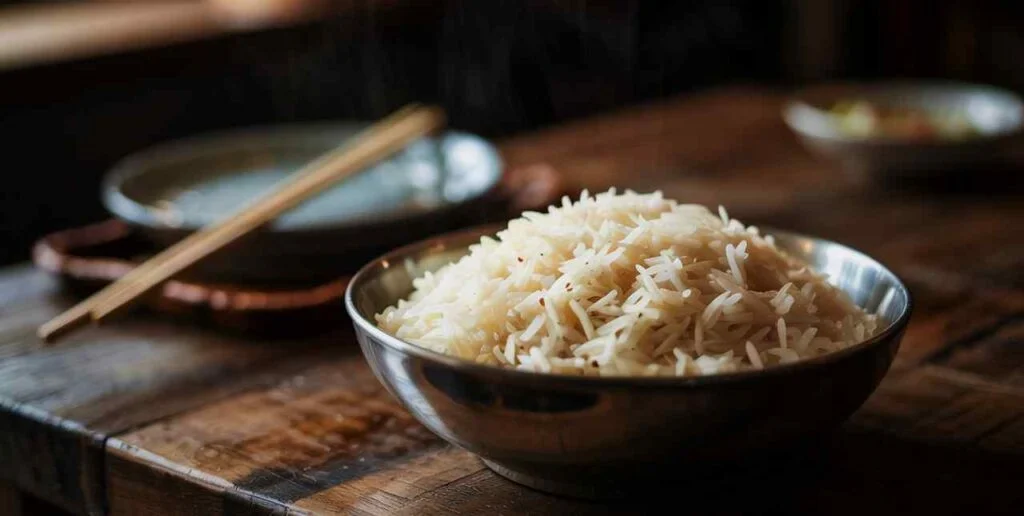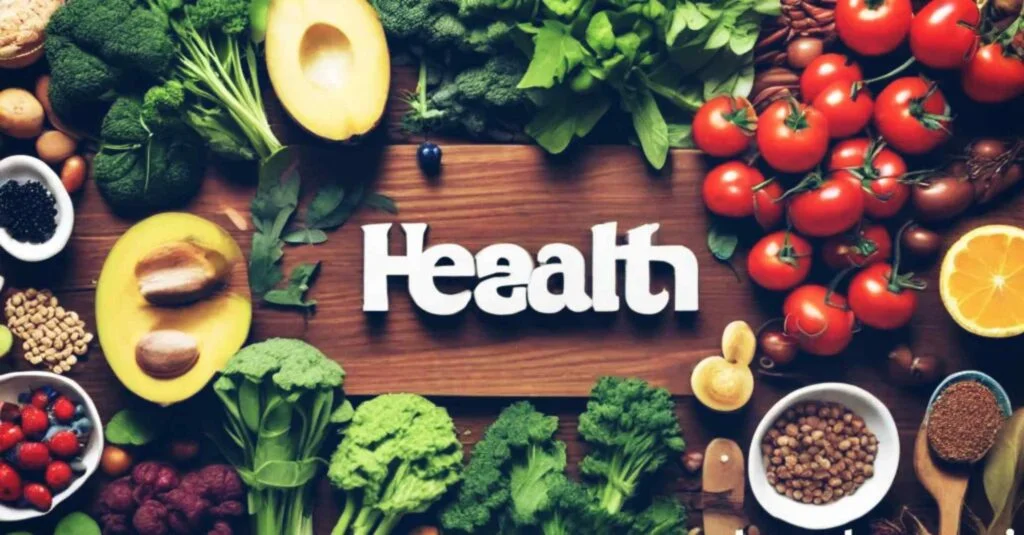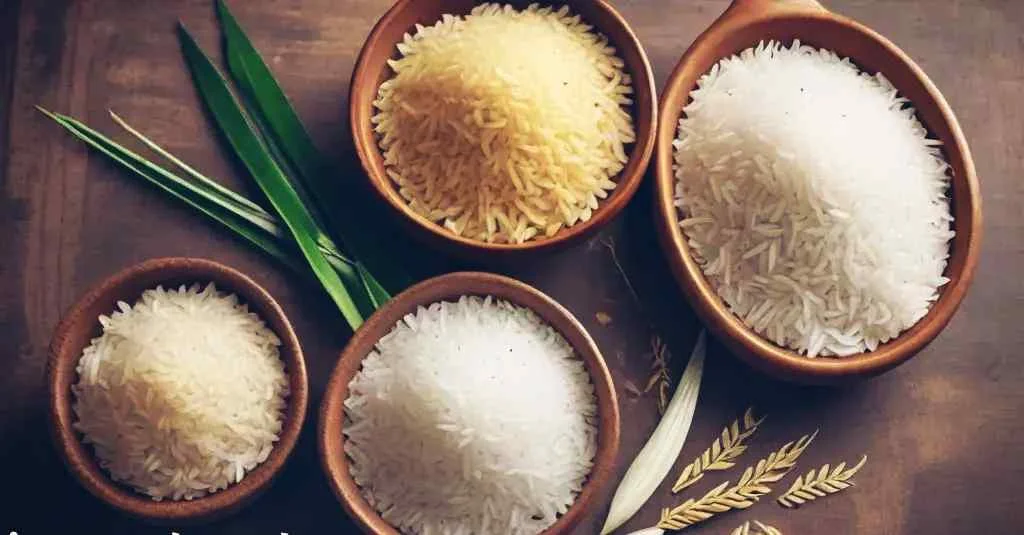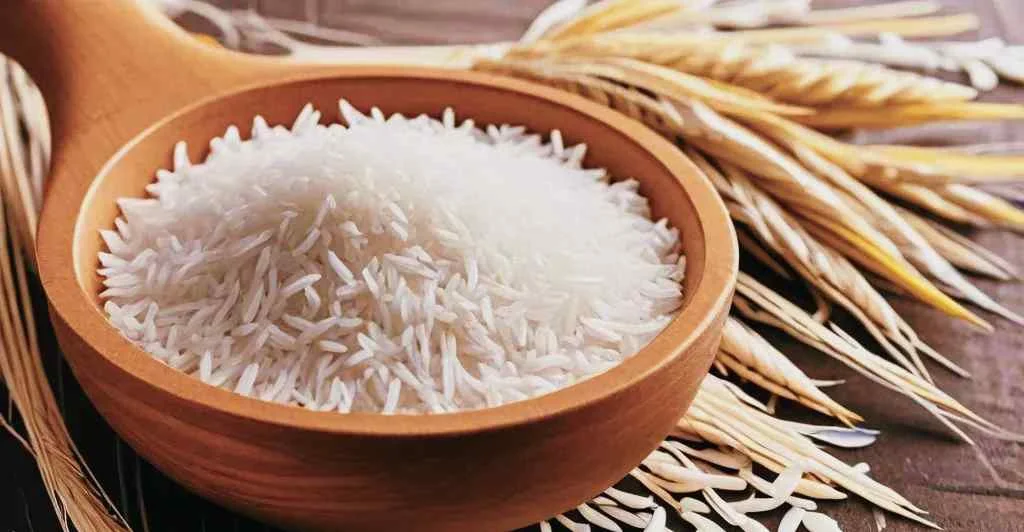Have you ever thought, “Wow, that smells like magic,” after sniffing a pot of boiling rice? Basmati rice is what I have here. For thousands of years, farmers in India and Pakistan have raised this unique grain.
In Sanskrit, an ancient language from long ago, the term “basmati” means “fragrant.” Its nutty scent makes your nose happy and its long, thin grains dance in your bowl.
Not just any rice—basmati rice is really important in many countries, particularly in South Asia. It’s used at dinners, celebrations, and weddings as well as for appetisers. They appreciate its unique flavour and how it complements so many other cuisines.
Today, we’ll look into the basmati rice nutrition facts—a package full of healthful surprises waiting for you!
What is Basmati Rice?

Basmati rice isn’t like the rice you see every day. Absolutely not! It grows in the hazy slopes of the Himalayas, where it sucks up the finest of nature. The word “basmati” means “fragrant” in Sanskrit, and it truly lives up to that reputation. Picture rice that smells like flowers or toasted nuts—pretty great, huh?
That fragrance originates from something called 2-acetyl-1-pyrroline. It’s a fancy word for a wonderful thing that’s also in pandan leaves and fresh bread. Basmati rice has more of it than regular rice, therefore its scent is especially exquisite.
People enjoy basmati rice because the grains don’t cling together. They stay fluffy and distinct, making every mouthful very exciting. This happens because it has less sticky starch than ordinary rice. Think about recipes like biryani or pilaf—basmati is the star there! It soaks up tastes like a sponge yet preserves its form, which is why cooks and families select it time and over.
Here’s something neat: some people claim basmati rice provides good luck at weddings! In certain regions, they throw it like confetti. How fun is that? It’s a sign of prosperity and happiness, wishing the new couple a prosperous life. Did you know basmati rice is aged like great wine? Farmers preserve it for months or even years, and it grows sweeter the longer it stays!
Basmati Rice Nutrition Facts
Let’s check into this rice. What’s it got? Nutrition is all about the things that keep you strong and cheerful. Here’s what you receive with one cup of cooked basmati rice:
- Calories: 200—energy to run and play all day! Calories are like small power packets for your body. They help you move, think, and grow.
- Carbohydrates: 45 grams—fuel for your body’s motor. Carbs offer your brain and muscles the energy they need. They’re like gas for an automobile!
- Protein: 4 grams—helpers for your muscles. Protein heals you up and makes you tough. It’s like bricks forming a solid home.
- Fat: 0.5 grams—just a small bit to make it light. Fat helps your body consume some vitamins and delivers a little energy, but you don’t need a lot.
- Fiber: 0.6 grams—a boost for your gut. Fiber keeps your stomach happy and moving. It’s like a broom sweeping out the garbage.
- Extras: B vitamins (such B1 and B3) and minerals (iron, magnesium)—small sparks of health! B1, or thiamine, transforms food into energy. B3, or niacin, keeps you perky. Iron carries oxygen in your blood, while magnesium keeps your bones strong.
Calories keep you going. Carbs replenish your tank. Protein builds you up, whereas fat slips in silently. Fiber cleans your gut. These basmati rice nutrition facts demonstrate it’s not only yummy—it’s a superhero for your body! Knowing the basmati rice nutrition facts helps you chose sensible meals for every meal.
Health Benefits of Basmati Rice

Basmati rice distributes wellness like fairy dust. First, it’s good to your blood sugar. Blood sugar is the sweet substance in your blood—too much, too fast, can create issues. Basmati increases slowly, which is perfect if you watch your sugar. It has a low to medium glycemic index, so it doesn’t shoot up rapidly. That’s fantastic for folks with diabetes or anyone keeping their weight in check!
Next, fiber flies in to aid. Basmati doesn’t contain as much fiber as brown rice, but it still delivers some. Fiber fills your belly so you don’t eat too much. It also scrubs your insides clean for a healthy gut. Do you ever feel full and heavy after food? Not with basmati—it’s light and simple to stomach. Its low fat and fluffy texture make it a pleasant embrace for your tummy.
Oh, and it’s gluten-free! No gluten creeps in here, so everyone can eat it. Gluten is in wheat, barley, and rye, and some individuals can’t have it. Basmati rice is safe for persons with celiac disease or gluten issues.
Here’s a fun twist! Some cooks claim basmati rice makes you happier. Maybe it’s the smell—pure ecstasy in every whiff. That beautiful perfume might brighten you up and make dining more pleasant. Good food keeps your body and heart happy, and basmati does both. These basmati rice nutrition statistics suggest it’s a winner for health and smiles!
Comparison with Other Rice Types

How does basmati compare? Let’s put it in a race with white rice and brown rice. White rice is all over the place—simple and straightforward.
But it loses its outer layer, called bran, where most of the nutritious stuff lurks. So, it’s short on fiber, vitamins, and minerals. Basmati is white rice too, but it’s unique. It preserves more nutrients because of how it’s cultivated and prepared. It beats plain white rice with a bit extra fiber and vitamins.
Brown rice is the strong one—full of fiber and health goodness. It preserves its bran layer, filled with fiber, B vitamins, and antioxidants. It’s wonderful for your heart and gut. But some feel it’s excessively chewy or hefty. Basmati wins with its smoothness and scent. It’s pleasant to eat and tastes sophisticated, suitable for lots different meals.
Imagine this: white rice is quiet and bashful. Brown rice is huge and bold. But basmati dances in the middle—tasty and healthful all at once! The basmati rice nutrition statistics give it an edge over regular white rice, even if brown rice has more power.
How to Include Basmati Rice in Your Diet

Ready to try this treasure? You may eat basmati rice in hundreds of ways! Start easy: prepare basmati rice with vegetables and chicken. Fry up onions, carrots, and peas in a pan. Add cooked chicken and basmati rice, then add some soy sauce or seasonings. Yum—a party in your mouth!
Or make it chilly! Cook basmati rice, let it cool, then combine it with black beans, corn, diced tomatoes, and a splash of lime. It’s a fresh, tangy salad for hot days.
Soups enjoy it too! Throw some cooked basmati rice into your favorite soup. It makes it richer and more filling—a comforting delight for winter nights.
Love fish? Cook some fish or tilapia and serve it on basmati rice. The rice soaks up the fishy tastes like a sponge. Add steamed broccoli or green beans on the side—super yummy!
Here’s a way to cook basmati rice exactly right: rinse it beforehand! Wash it under water to get rid of excess starch. Then use two cups of water for one cup of rice. Boil it, reduce the heat low, and let it simmer for 15 minutes. Fluff it with a fork, and you’re a cooking star!
Ever tried it sweet? Basmati rice with dessert is wild fun! Cook it with milk, sugar, and vanilla for velvety rice pudding. Toss in raisins or cinnamon—it’s like a hug in a bowl. These ideas make the basmati rice nutrition facts come alive in your kitchen!
Fun Facts About Basmati Rice
Want more? Basmati rice has surprises! It’s like a chameleon—when it cooks, it turns from hazy to clear. That’s a nice trick! Plus, it grows best near rivers and mountains, where the soil is exactly ideal. Farmers work hard to make it ideal.
In India, some nickname it the “queen of rice” since it’s so elegant. Chefs throughout the world utilise it for distinctive recipes. It’s not just food—it’s a tale on your plate!
Conclusion
So, basmati rice isn’t simply rice—it’s an adventure! The basmati rice nutrition facts demonstrate it’s full of energy, power, and belly love. It’s light on your blood sugar, easy to digest, and gluten-free, so it fits practically everyone.
Plus, its beautiful scent and airy grains turn meals become enjoyable. Next time you’re at the grocery, get some basmati rice. Cook it, smell it, eat it—you’ll grin with every bite! Food should fuel your body and spirit, and basmati rice does it everything.
FAQs
Is basmati rice gluten-free?
Yes! No gluten here—it’s beneficial for all stomachs, even if you can’t eat wheat.
Can I consume basmati rice on a diet?
Sure! Keep it little, like half a cup. Add veggies like spinach or carrots for a healthy win.
How much basmati rice should I eat?
Half a cup to one cup, depending on how hungry you are. Active kids might want more!
Are there vitamins in basmati rice?
Yep! B1 and B3 provide you energy and keep you joyful all day
Is basmati rice superior to normal white rice?
Oh, sure! It contains more nutrients and a smoother sugar rise—more fun too!
Does basmati rice carry antioxidants?
A little! It includes microscopic helpers called phenolic compounds that defend your body.
Can basmati rice aid in weight loss?
Yes, if you don’t consume too much. Its fiber fills you up, yet minimal fat keeps it light.


Basmati rice is truly a gem, isn’t it? Its fragrance and texture make it stand out among other types of rice. I love how it carries such deep cultural significance, especially in South Asia. It’s fascinating that something as simple as rice can hold so much history and tradition. I wonder, though, how does its nutritional profile compare to other varieties? It’s amazing that it’s not just delicious but also packed with health benefits. Have you ever tried cooking with basmati rice yourself? I’d love to hear your favorite recipe or dish that highlights its unique flavor!
thank you for giving a review